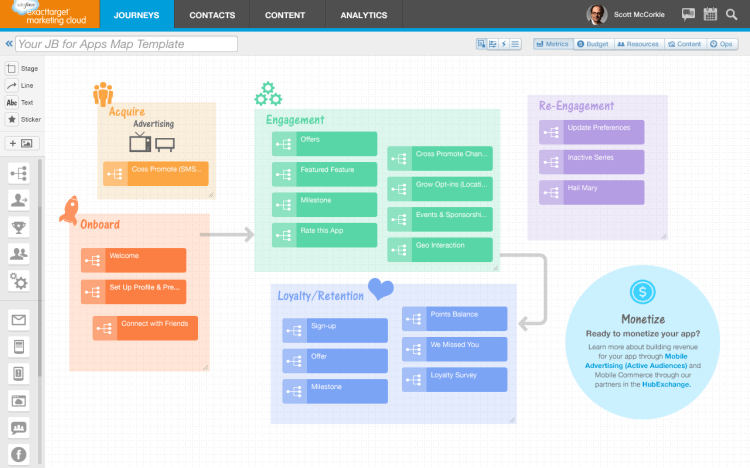Mobile is computing’s new center of gravity, and apps are the core of mobile. To help marketers direct their efforts toward this critical part of digital experience, Salesforce is releasing its “Journey Builder for Apps” today.
In July, Salesforce launched its Journey Builder for creating unified customer experiences across a variety of channels, including the Web, social, email, apps, and so forth.
Journey Builder for Apps is a more specialized tool, similarly built on the Salesforce1 Platform and integrated with the ExactTarget Marketing Cloud, and it allows marketers to plot how app usage fits into a customer’s overall journey from prospect to customer, utilizing maps, interactions and analytics.
“Apps are a new channel,” Salesforce vice president of product marketing Gordon Evans told VentureBeat. He said this new addition to Journey Builder integrates app marketing more completely into customer journeys, and offers a SDK for integrating Journey Builder with apps.
Salesforce is also announcing that a version of Heroku, called Heroku DX, will enable the company’s cloud-as-a-service to serve as a platform for apps that integrate with Journey Builder for Apps.
Inside Journey Builder for Apps
Journey Templates are pre-built assets in the new tool. They include ready-to-use community web pages that can customize content to a user’s particulars.
By integrating apps more fully into overall multi-channel marketing campaigns that also include email and social ads, and by getting deeper into the mobile app management space, Salesforce hopes Journey Builder can help to drive app downloads, encourage app engagement, and, of course, provide data about what app users do.
The customer journeys, the company said, are triggered by interactions with the app, and companies using Journey Builder can then address those customers through such means as personalized emails encouraging app downloads, or through messages or ads sent to the app.
Other options include publishing new in-app content, such as loyalty program updates, that responds to contextual information — like how much an app has been recently used. You can also set wait times or triggers that depend on specific user actions.
How about that sweater?
As an example use case, Salesforce suggested that a customer who looks at the same sweater multiple times on an app could automatically get a message about a discount on that item.
Or, if a customer doesn’t buy tickets after using an app to check a band’s concert dates, to give another example, you could automatically send a message about upcoming concert dates.
And, in a sign of how fitness apps might respond to our exercise patterns, Salesforce suggests that an app on a wearable could show an invite to join a competitive exercise group, once the customer reached an exercise goal.
“Lots of apps get downloaded,” Evans told us. The question is, “How do you drive adoption of these apps, [through] continued engagement?”
Triggers can also be based on information from beacons, wearables, or geo-fencing in physical stores.
Salesforce is increasingly “thinking about location as part of [customer] journeys,” Evans said, especially since the company sees mobile apps themselves as being a convergence of digital and physical worlds.
Accompanying the unveiling of Journey Builder for Apps, Salesforce is also announcing an alliance with global ad and marketing group Omnicom to create “an integrated customer journey platform” for use by Omnicom’s various agencies, including BBDO, DDB, and TBWA.
VentureBeat's mission is to be a digital town square for technical decision-makers to gain knowledge about transformative enterprise technology and transact. Learn More

